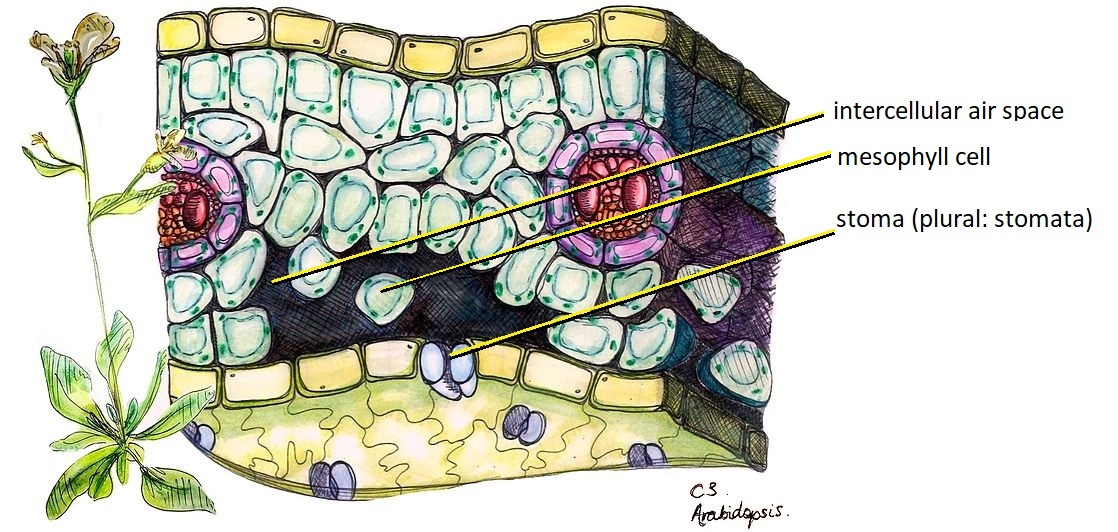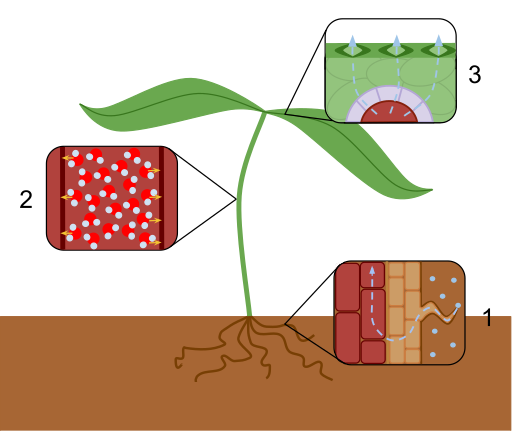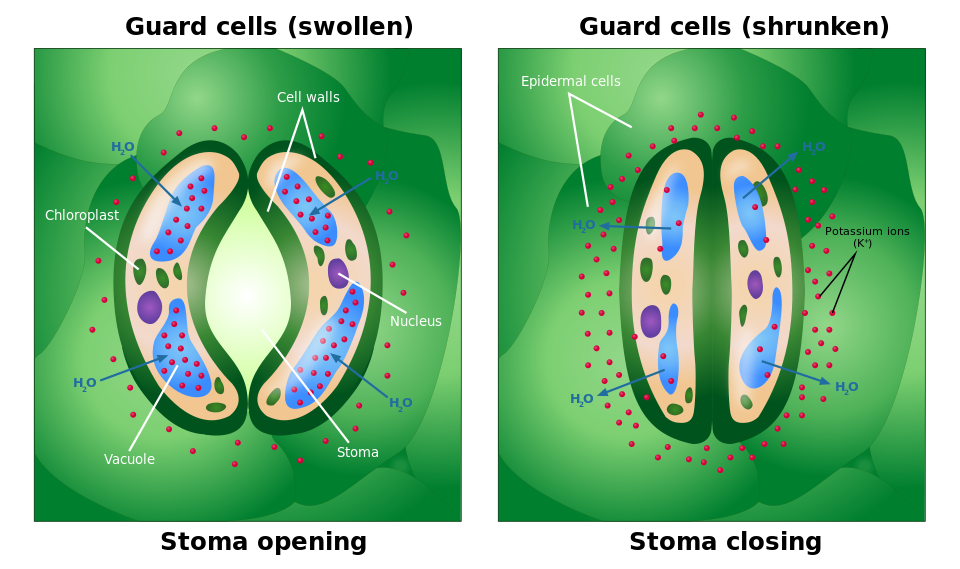OCR Specification focus:
‘Transpiration arises from gaseous exchange; evaluate how factors such as light, temperature, humidity and air movement affect transpiration rate.’
Transpiration is the loss of water vapour from plant leaves via stomata, driven by gaseous exchange needs and environmental conditions. It underpins water transport, nutrient movement, and cooling.
The Nature and Process of Transpiration
Transpiration occurs primarily through stomata, tiny pores in the leaf epidermis controlled by guard cells. Water evaporates from the moist cell walls of the mesophyll into the air spaces and diffuses out through open stomata into the external atmosphere.

A labelled leaf cross-section (Arabidopsis) showing palisade/spongy mesophyll, intercellular air spaces, and stomata in the epidermis. Water evaporates from mesophyll cell walls into the air spaces and diffuses out through stomata. This structural context explains why humidity and wind alter the diffusion gradient and boundary layer. (Note: the figure also includes general tissue labels beyond the minimum OCR requirements, which remain directly supportive of transpiration concepts.) Source.
Transpiration: The process by which water vapour is lost from the aerial parts of a plant, mainly through the stomata of leaves.
This process establishes a transpiration pull, a component of the transpiration stream, which moves water from roots to leaves through the xylem.

A labelled overview of transpiration: water is drawn from roots into xylem, moves to spongy mesophyll, and evaporates through stomata, generating tension in the continuous water column. The diagram highlights cohesion–adhesion and the evaporation step at the leaf surface. This visual supports the explanation of a maintained diffusion gradient. Source.
The cohesion and adhesion properties of water enable continuous column movement within xylem vessels.
The movement of water vapour out of the leaf is a diffusion process, dependent on the gradient between the internal leaf air spaces and the external environment. Transpiration is an unavoidable consequence of gas exchange required for photosynthesis.
Importance of Transpiration
Although transpiration results in water loss, it has vital physiological functions:
Maintains water uptake: Continuous water movement draws minerals and ions from the soil.
Drives the transpiration stream, ensuring delivery of water to cells for turgor maintenance.
Enables evaporative cooling, preventing overheating in sunlight.
Supports photosynthesis, as open stomata allow gas exchange.
Transpiration is therefore closely linked to environmental variables that influence stomatal behaviour and evaporation rates.
Factors Affecting Transpiration Rate
Light Intensity
Light plays a major role by influencing stomatal opening. Stomata open in the presence of light to allow carbon dioxide entry for photosynthesis, which inevitably increases water loss.

A labelled guard-cell diagram showing stomatal opening and closing, driven by solute (e.g., K⁺) movements that alter guard-cell water potential and turgor. Wider apertures facilitate CO₂ uptake but increase water vapour loss. This mechanistic view supports how light (and other cues) change transpiration rate via stomata. Source.
In bright light, transpiration rate increases as stomata widen.
At night, stomata close, leading to a sharp decrease in water loss.
Plants adapted to dry environments may reduce stomatal opening even during the day to conserve water.
Temperature
Temperature affects both the rate of evaporation from mesophyll cells and the diffusion rate of water vapour into the air.
Higher temperatures increase kinetic energy of water molecules, promoting faster evaporation from cell walls.
Warm air can hold more water vapour, steepening the water potential gradient between leaf and atmosphere.
Consequently, transpiration increases in hot conditions.
In very high temperatures, however, some plants close their stomata temporarily to avoid excessive water loss.
Humidity
Humidity refers to the concentration of water vapour in the air surrounding the leaf. It directly determines the steepness of the diffusion gradient.
When humidity is low, the external air has less water vapour, increasing the gradient and promoting faster diffusion.
When humidity is high, the external and internal water vapour concentrations are similar, reducing transpiration.
Thus, transpiration rate is inversely proportional to humidity.
Air Movement (Wind Speed)
Air movement removes the moist air layer from around the leaf surface, maintaining a steep concentration gradient for diffusion.
In still air, water vapour accumulates near the leaf, forming a boundary layer that reduces transpiration.
Wind disperses this boundary layer, increasing transpiration rate.
Extremely strong winds may, however, cause stomatal closure to prevent water loss.
Therefore, moderate air movement promotes the highest transpiration efficiency.
Water Availability and Soil Conditions
Transpiration depends on a continuous supply of water from the roots. When soil water is limited:
Root water uptake decreases.
Leaf water potential falls, leading to stomatal closure.
Transpiration rate declines to conserve remaining water.
Prolonged water shortage leads to wilting, reducing leaf surface area exposed to sunlight and further limiting transpiration.
Internal Plant Factors Influencing Transpiration
While the environment exerts a major influence, internal factors also play a role:
Number, size, and distribution of stomata: More stomata per unit area increase potential for water loss.
Thickness of the cuticle: Waxy cuticles reduce water loss by evaporation through epidermal cells.
Leaf surface area: Larger leaves with higher surface areas lose more water.
Leaf adaptations: Sunken stomata, trichomes (leaf hairs), and rolled leaves help reduce transpiration in xerophytes.
Xerophyte: A plant adapted to live in dry environments with features that minimise water loss through transpiration.
These adaptations demonstrate how plants balance water conservation with gas exchange needs.
Measurement of Transpiration
The rate of transpiration can be investigated using a potometer, which measures water uptake rather than water loss directly.
Potometer: An apparatus used to estimate the rate of water uptake by a plant shoot, assumed to correlate with transpiration rate.
A column of water moves along a capillary tube as the plant transpires, and the movement of an air bubble indicates water uptake over time.
Although not all absorbed water is lost by transpiration, the correlation provides valuable comparative data under controlled conditions.
Environmental variables such as light intensity, temperature, humidity, and air movement can be systematically varied in potometer experiments to observe their impact on transpiration rate.
Summary of Environmental Influences
High light intensity → stomata open → transpiration increases
High temperature → faster evaporation and diffusion → transpiration increases
Low humidity → steep water potential gradient → transpiration increases
High air movement → removes boundary layer → transpiration increases
Low soil water → stomata close → transpiration decreases
Together, these factors demonstrate the dynamic nature of transpiration as plants continually adjust to changing environmental conditions, maintaining a balance between efficient gas exchange and water conservation essential for survival and productivity.
FAQ
Plants use stomatal regulation to achieve this balance. Guard cells control the opening and closing of stomata depending on environmental signals.
In high light, stomata open to allow carbon dioxide entry for photosynthesis.
When water is limited or temperatures are high, stomata close to reduce water loss.
Some plants have adaptations such as sunken stomata, waxy cuticles, or reduced leaf surface area to further limit transpiration while maintaining sufficient gas exchange for survival.
Transpiration is beneficial because it:
Maintains the transpiration stream, moving water and minerals to leaves.
Enables cooling through evaporative water loss.
Supports turgor pressure, keeping cells firm.
However, excessive transpiration can be harmful. During drought or heat stress, water loss may exceed uptake, leading to wilting, stomatal closure, and reduced photosynthetic activity. Prolonged imbalance can damage leaf tissues and impair growth.
Xylem vessels are composed of elongated, dead cells joined end-to-end to form continuous tubes for water transport. Their lignified walls prevent collapse under tension.
Water is pulled upwards by:
Cohesion: attraction between water molecules.
Adhesion: attraction between water molecules and xylem walls.
Transpiration pull: created by evaporation from mesophyll cells.
This structural and physical combination allows water to move efficiently from roots to leaves even against gravity.
Guard cells respond to environmental stimuli through receptor-mediated signalling.
Light triggers proton pumps in guard cells, lowering internal water potential and causing stomatal opening.
Abscisic acid (ABA), a stress hormone, accumulates under water deficit, causing stomatal closure.
Temperature and humidity indirectly influence guard cell turgor via water potential changes in surrounding tissues.
These responses occur rapidly to maintain internal water balance and optimise photosynthesis.
The distribution of stomata reflects a plant’s habitat and transpiration needs.
Dorsiventral (typical dicot) leaves usually have more stomata on the lower surface to reduce direct exposure to sunlight, limiting water loss.
Isobilateral (monocot) leaves or aquatic plants often have stomata on both surfaces because humidity or water availability reduces the risk of dehydration.
This arrangement ensures efficient gas exchange and water regulation suited to environmental conditions.
Practice Questions
Question 1 (2 marks)
Explain why transpiration increases when the air around a leaf becomes drier.
Mark Scheme:
1 mark for stating that a lower humidity outside the leaf increases the water potential gradient between the inside and outside of the leaf.
1 mark for explaining that this steeper gradient causes water vapour to diffuse out of the stomata more quickly.
Question 2 (5 marks)
Describe how two environmental factors and one internal plant factor affect the rate of transpiration.
Mark Scheme:
1 mark for correctly identifying each of the three factors (any two environmental, one internal): e.g. light intensity, temperature, humidity, air movement, number of stomata, thickness of cuticle, or leaf surface area.
1 mark for describing how light intensity affects transpiration: stomata open in light to allow gas exchange, increasing water loss.
1 mark for describing how temperature affects transpiration: higher temperature increases kinetic energy of water molecules, raising evaporation and diffusion rates.
1 mark for describing how an internal factor (e.g. cuticle thickness or number of stomata) affects transpiration, such as a thick waxy cuticle reducing evaporation or more stomata increasing water loss.
1 mark for clarity and correct biological terminology (e.g. “water potential gradient,” “stomatal aperture,” “diffusion rate”).

